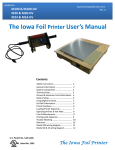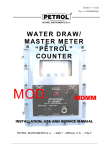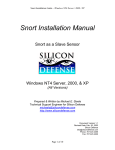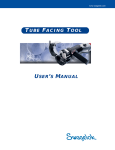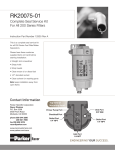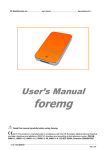Download Plastic Tube Flaring System: Model FTF 1000 User's Manual (MS
Transcript
www.swagelok.com Plastic Tube Flar ing Syste m Mode l F TF 10 0 0 Use r’s Ma nual Safety Instructions . . . . . . . . . . . . . . . . . . . . . . . . . . 2 General Information . . . . . . . . . . . . . . . . . . . . . . . . . 2 Setup Tubing Selection and Preparation . . . . . . . . . . . . . . 3 Flaring System Setup . . . . . . . . . . . . . . . . . . . . . . . . 4 Operation Heating . . . . . . . . . . . . . . . . . . . . . . . . . . . . . . . . . . . 5 Flaring . . . . . . . . . . . . . . . . . . . . . . . . . . . . . . . . . . . . 6 Shutdown and Storage . . . . . . . . . . . . . . . . . . . . . . . 7 Tube Flaring Length Guide . . . . . . . . . . . . . . . . . . . . 8 Good Flares. . . . . . . . . . . . . . . . . . . . . . . . . . . . . . . . . 8 Troubleshooting . . . . . . . . . . . . . . . . . . . . . . . . . . . . . 9 Replacement Parts. . . . . . . . . . . . . . . . . . . . . . . . . . . 11 Warranty . . . . . . . . . . . . . . . . . . . . . . . . . . . . . . . . . . . 11 2 Plastic Tube Flaring System User’s Manual Safety Instructions READ THIS MANUAL BEFORE USING THE SWAGELOK® TUBE FLARING SYSTEM. This device is electrically powered and must be operated in a safe environment to avoid risk of fire, explosion, or electric shock. Statements CAUTION! Statements that identify conditions or practices that could result in damage to the equipment or other property. WARNING! Statements that identify conditions or practices that could result in personal injuries or loss of life. Symbols PINCH POINTS Keep hands, loose clothing, and long hair away from moving parts. Serious injury can occur. HOT SURFACE Heating unit of flaring system and heated tubing will be very hot during operation. General Information WARNING! NO USER SERVICEABLE COMPONENTS INSIDE The FTF 1000 plastic tube flaring system contains no user-serviceable parts, except for fuses. Contact your authorized Swagelok® sales and service representative for service. WARNING! DO NOT EXPOSE FLARING TOOL TO MOISTURE. SYSTEM COMPONENTS ARE NOT WATERPROOF. Technical Data Ordering Number MS-FT-1-1 MS-FT-1-3 MS-FT-1-5 MS-FT-2-2 MS-FT-2-4 MS-FT-2-6 MS-FT-2-7 MS-FT-2-8 Power Requirements Maximum Current 115 V (AC), 50/60 Hz 4 Amps 230 V (AC), 50/60 Hz 2.5 Amps Ground and Extension Cord Information Tube flaring system MUST be grounded against electrical shock. It is equipped with a three-wire conductor and three-prong plug to fit a grounded receptacle. NEVER CONNECT THE GREEN OR GREEN/YELLOW WIRE TO A LIVE TERMINAL! Use only three-wire extension cords that have three-prong, grounding-type plugs and three-pole receptacles. The extension cord wire size must meet the following specifications: For 0 to 25 ft (0 to 7.5 m), the recommended minimum wire gauge is 14 AWG or 2.5 mm. For 25 to 50 ft (7.5 to 15 m), the recommended minimum wire gauge is 12 AWG or 4.0 mm. Plastic Tube Flaring System User’s Manual Setup Tube Selection and Preparation The Swagelok FTF 1000 plastic tube flaring system is designed to flare fluoropolymer tubing for use with fine thread flare end connections. The following tubing sizes can be flared on this system: Tubing Tubing Size in. Wall Thickness in. 1/4 0.047 3/8 0.063 1/2 0.063 3/4 0.063 1 0.063 1. Select appropriate size of tubing. 2. Tubing must be clean and free of grease, dirt, and other contaminants. 3. Cut the end of the tubing to be flared square (90° ± 10° recommended). 4. Insert the cut end of the tubing through the fine thread flare nut. See Fig. 1. Fig. 1 Fine thread flare nut 3 4 Plastic Tube Flaring System User’s Manual Flaring System Setup 1. 2. 3. 4. 5. 6. Select an appropriate location that is clean, well lit, well ventilated, and away from flammable fumes and materials. Set the system on a flat, stable surface. Insert the power cord into the side of the system. See Fig. 2. Plug the other end of the power cord into a power source appropriate for the voltage of the system. Turn on the system using the switch just above the power cord. Set the heat temperature, heating time, and cool down time by pressing and holding down the appropriate button on the control panel, “HEAT TEMP”, “HEATING TIME” or “COOLING TIME”. Use the arrow buttons to reach the desired setting according to the guidelines in Table 1 for the selected tubing. See Fig. 3. Switch (On position) Power cord Fig. 2 Table 1 PFA 450 HP Settings Tubing Size in. Heat Temperature °C Heating Time s Cooling Time s 1/4 220 20 30 3/8, 1/2, 3/4, and 1 295 40 30 Note: Guidelines are based on DuPont™ Teflon® PFA 450 HP tubing. Adjustments may be needed due to material variation and type of tubing being used. 7. Wait for “Set Temperature Reached” indicator on the control panel to light, then proceed to Operation. Note: If the flaring system is not operated for a period of approximately 2 1/2 hours, the system will automatically enter a standby mode with the heater shutting off and the system cooling. Press any button on the control panel to reactivate system, and then wait for “Set Temperature Reached” indicator on the control panel to light. Fig. 3 Plastic Tube Flaring System User’s Manual Operation Heating 5 Clamping arm Heater block Ram arm WARNING! HOT SURFACE Surface of heater block will be extremely hot. Do not touch heater block. Retract upper tube clamp to the fully open position by moving the clamping arm in the direction shown. See Fig. 4. 2. Use the ram arm to match up the lines on the ram to the “START” position marked on the frame. The ram arm will reach a positive detent. See Figs. 4 and 5. 3. Insert prepared tubing into the appropriate size hole of the heater block until the tubing reaches the positive stop. See Fig. 6. 1. Upper tube clamp Frame Fig. 4 Ram Note: Each hole in the heater block is marked with the tubing size. See Fig. 7. 4. The timer will start automatically with the system display showing the countdown to completion of the preset heating time. After heating has been completed an audible alarm will sound, and the “Heating Cycle Complete” indicator will blink. Frame Start position Fig. 5 WARNING! HOT SURFACE The end of the tube removed from the heating block will be extremely hot. 5. Remove tubing from the heater block. If necessary, twist the tubing slightly to help with the tubing removal. Note: The tubing must be quickly placed on the appropriate flare mandrel upon removal or tubing will begin to cool. (See Flaring). Insert tubing Fig. 6 3 ⁄8 1⁄2 3⁄4 1 1⁄4 Fig. 7 Heater block 6 Plastic Tube Flaring System User’s Manual Flaring 1. Slide the heated tubing onto the appropriate sized flaring mandrel to the beginning of the chamfer. See Figs. 8 and 9. CAUTION! It is important to place the tubing at the beginning of the chamfer. Mandrel Chamfer Tube Mandrel Mandrel Chamfer Tube Incorrect Tube Placement Tube Incorrect Tube Placement 3/4 1/4 1/ 1" 3/8 2 Correct Tube Placement Chamfer START Fig. 8 WARNING! PINCH POINTS. Be careful not to pinch fingers when clamping the tubing. Clamping arm 2. Quickly clamp the tubing by rotating the clamping arm completely forward until it locks into place. See Fig. 9. Fig. 9 Plastic Tube Flaring System User’s Manual WARNING! PINCH POINTS Be careful not to pinch fingers when moving the ram forward with the ram arm. Ram arm 3. Quickly move the ram arm completely forward until it locks into place. The timer will start automatically once the arm is completely forward. After the cooling time has been reached an audible alarm will sound and the “Cooling Cycle Complete” indicator will blink. See Fig. 10. 4. Return the ram arm completely to its original position, past the “START” position marked on the frame. See Fig. 8. 5. Return the clamping arm to the fully open position. See Fig. 12. 6. Remove the tubing. The flared tubing is ready for installation or storage. Note: Return the ram arm back to the “START” line position marked on the frame. See Fig 12. Fig. 10 Ram arm Shutdown and Storage 1. To shut the system down, turn off the power using the switch just above the power cord on the system. WARNING! HOT SURFACE The system will remain hot for 2 1/2 hours after the power is turned off. Do not place system back into case until it is fully cooled. 2. For storage, remove the power cord and place it inside the case. Place the system into the case. Fig. 11 Clamping arm Ram arm Fig. 12 7 8 Plastic Tube Flaring System User’s Manual FTF 1000 Tube Flaring Length Guide To determine the original length of tubing B needed to result in the desired length A. See below. One end flared: B=C+A Two ends flared: B = 2C + A A = Final desired length from fitting nose to fitting nose B = Original length of tubing required to obtain A Tubing Size in. Dimensions, in. C 2C 1/4 0.55 1.1 3/8 0.6 1.2 1/2 0.6 1.2 3/4 0.6 1.2 1 0.7 1.4 Good Flares Good flares should be consistent around the circumference of the tubing. All angles should be sharp and consistent, with no deformed areas. See Fig. 13. Fig. 13 Good flare Plastic Tube Flaring System User’s Manual Troubleshooting Cause: The temperature was set too high, the heating time was too long, or both. See Fig. 14. Solution: Decrease the temperature and/or the heat time. Fig. 14 Temperature too high and/or heat time too long Cause: The temperature was too low, the heating time too short, or both. See Fig. 15. Solution: Increase the temperature and/or the heat time. Cause: Too much time elapsed between removal of tubing from heater block to placement on flaring mandrel. See Fig. 15. Solution: Ensure that you place the tubing on the mandrel immediately after removing it from the heater block. The ram arm was too far back from the “START” position or the tubing was pushed past the beginning of the chamfer, causing the flaring mandrel to overtravel and deform the tubing. See Fig. 16. Solution: Ensure that the start position alignment marks are properly aligned. Fig. 15 Temperature too low and/or heat time too short Cause: Fig. 16 Improper ram position or tubing was pushed past chamfer Cause: The tubing was not positioned at the beginning of the flaring mandrel chamfer. See Fig. 17. Solution: Slide the heated tube all the way to the beginning of the chamfer. Fig. 17 Improper tube position 9 10 10 Plastic Tube Flaring System User’s Manual Adjusting the Photoeye Sensors If the system does not respond to the tubing being inserted into the heater block, the two photoeye sensors may require adjustment. Each photoeye sensor is activated by different tubing sizes. Photoeye sensor LEDs 1. Turn the system off and ensure that it has cooled completely. 2. Lift the system from the front and allow it to rest on end. 3. Locate the two slotted access holes on the underside of the system. See Fig. 18. 4. Turn the system on. Adjustment screws HOT SURFACE System will begin to heat up once it has been turned on. Fig. 18 5. Adjust each photoeye sensor adjustment screw using a small, flat-blade screwdriver. Turn the screw(s) clockwise so that the LED turns orange, then counter clockwise until the LED first turns green. CAUTION! If the adjustment screws are over adjusted, the timer will run continuously. 6. Turn the system off again and lower the system onto its base. Small flat-blade screwdriver Replacing the Fuses The tube flaring system is protected by two 10A, 250V, 5 mm x 20 mm fast blow fuses. If the tube flaring system fails to power on, check both fuses for continuity. 1. 2. 3. 4. 5. Ensure that the tube flaring system is turned off and unplugged. Locate the fuse holder, which is integrated with the power cord receptacle. See Fig. 19. Using a small, flat-blade screwdriver, gently pry open the fuse holder cover. See Fig. 19. Gently pry the fuse holder from the cord receptacle. See Fig. 20. Remove both fuses from the fuse holder and check for continuity. If either fuse has no continuity, the fuse has blown and must be replaced. Replace fuses with only the same type and rating. Spare fuses are available for purchase from your authorized Swagelok service center. See Fig. 21. Reinstall the fuses, taking care that the fuses are fully seated against the positive stops on the fuse holder. See Fig. 21. CAUTION! The fuses must be properly installed and fully seated against the positive stops on the fuse holder. 6. Reinsert the fuse holder into the cord receptacle and close the fuse holder cover. Fuse holder under cover Power cord receptacle cover Fig. 19 Fuse holder Power cord receptacle cover Fig. 20 10A, 250V, 5 mm x 20 mm Fast blow fuse Fuse holder Fuse holder positive stop Fig. 21 Plastic Tube Flaring System User’s Manual Replacement Parts Power Cords Geographic Region Voltage Ordering Number North America, Taiwan 110 V MS-BTB-CORD-1 North America 220 V MS-BTB-CORD-2 Japan 110 V MS-BTB-CORD-3 Japan, Taiwan 220 V MS-BTB-CORD-4 United Kingdom 110 V MS-BTB-CORD-5 United Kingdom, Singapore 220 V MS-BTB-CORD-6 Continental Europe 220 V MS-BTB-CORD-7 China, Australia, New Zealand 220 V MS-BTB-CORD-8 Fuse Ordering Number: MS-FUSE-G-S-10-250-A The Swagelok Limited Lifetime Warranty Swagelok hereby warrants to the purchaser of this Product that the nonelectrical components of the Product shall be free from defects in material and workmanship for the life of the Product. All electrical components installed in or on the Product are warranted to be free from defects in material and workmanship for twelve months from the date of purchase. The purchaser’s remedies shall be limited to replacement and installation of any parts that fail through a defect in material or workmanship. MANUFACTURER SPECIFICALLY DISAVOWS ANY OTHER REPRESENTATION, EXPRESS OR IMPLIED, WARRANTY, OR LIABILITY RELATING TO THE CONDITION OF USE OF THE PRODUCT, AND IN NO EVENT SHALL SWAGELOK BE LIABLE TO PURCHASER, OR ANY THIRD PARTY, FOR ANY DIRECT OR INDIRECT CONSEQUENTIAL OR INCIDENTAL DAMAGES. 11 Swagelok—TM Swagelok Company Teflon, DuPont—TM DuPont Only DuPont makes Teflon © 2004, 2005 Swagelok Company Printed in U.S.A. December 2005, R2 MS-13-171












